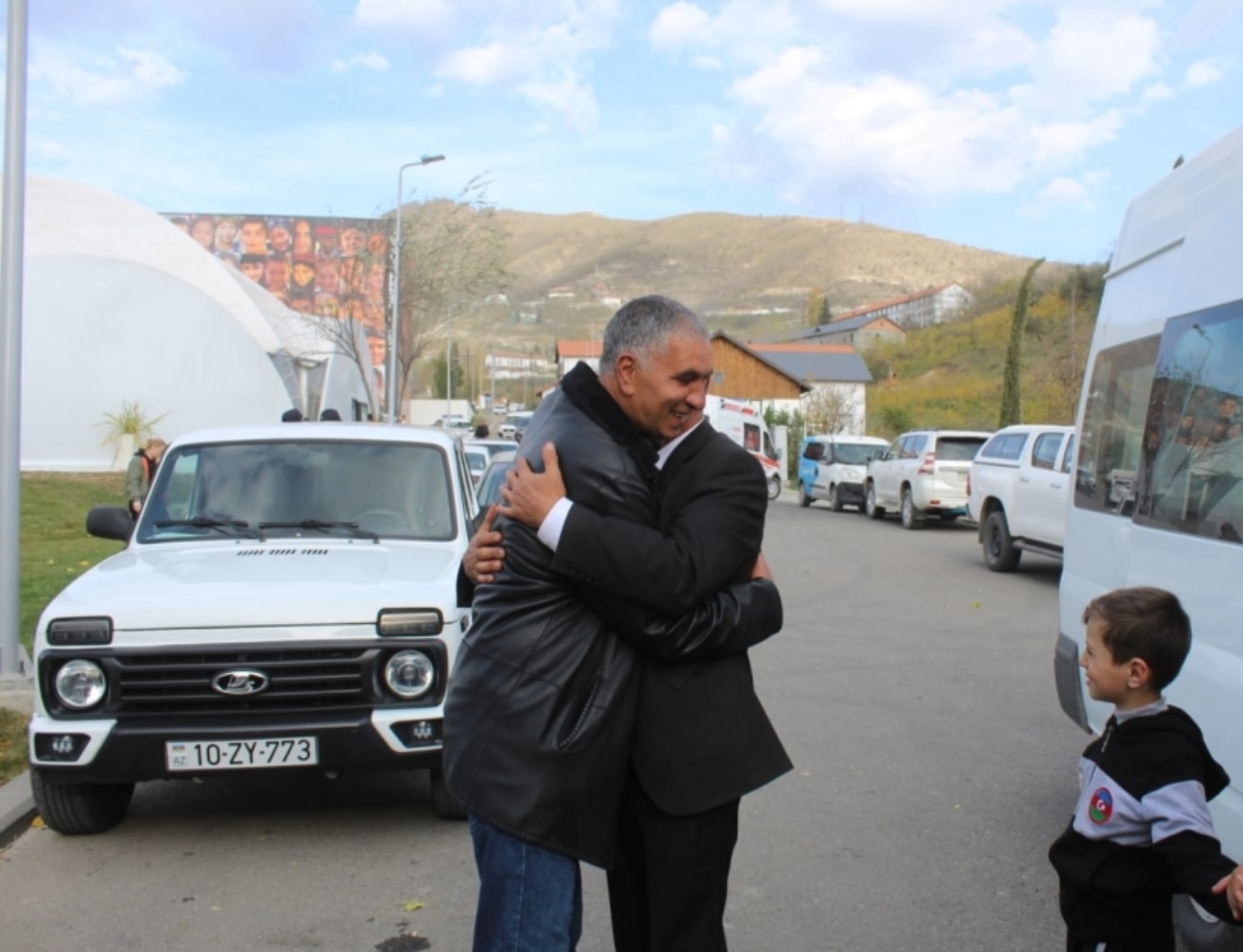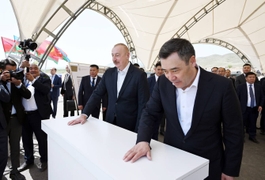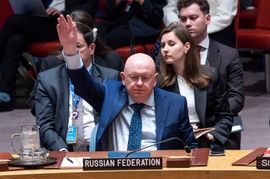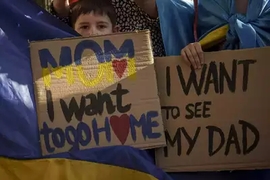The government of Azerbaijan completed on Tuesday the relocation of the next group of IDPs to the territories liberated from Armenian occupation.
Forty individuals of 10 families left for their permanent residences in the city of Lachin. Until their homecoming, they lived in the Garadagh district on the outskirts of Baku. With their arrival, the overall number of relocated people in Lachin reached 1,245.
The Azerbaijani government rolled out reconstruction projects in Lachin in August 2022, shortly after the city was reclaimed following the withdrawal of the Armenian military under the tripartite agreement signed in 2020.
By the end of 2023, 500 individual houses, eight high-rise buildings, and more than 30 administrative buildings will be built or reconstructed in Lachin. Lachin is expected to pioneer in the resumption of public transportation in the liberated Azerbaijani lands. The government is also considering launching a streetcar service on the city's central street in the near future.
Lachin, one of the largest districts in Azerbaijan spanning 1,800 square kilometers, was occupied by Armenia's armed forces on May 18, 1992.
As a result of Armenian aggression, 264 people were killed, 65 were taken hostage, and 103 became disabled. Additionally, 18 out of the 24,374 children in the district aged from one to 16 were killed, 225 were wounded, 1,071 children lost one parent, and 31 children lost both parents. Over 65,000 forcibly displaced Azerbaijanis from the Lachin district were accommodated in 59 other cities and districts of Azerbaijan.
During the occupation of Lachin, 217 cultural centers, 142 health facilities, 133 offices and enterprises, 100 secondary schools, preschool institutions, five musical schools, one boarding school, one vocational school, and one communication center were looted and destroyed by Armenia's forces.
Armenia's forces destroyed more than 200 historical monuments of local importance and 54 monuments of global significance, including the Albanian Agoglan monastery (6th Century), the tomb of Malik Azhdar (14th Century), a mosque in the village of Garagishlag, and an ancient cemetery in the village of Zabukh. Lachin History Museum and an old collection of gold, silver and bronze coins were plundered. An exhibit from the Lachin History Museum – a bag made of silver – was reportedly sold for $80,000 at Sotheby's in London.
Over the decades, Armenia and Azerbaijan had been locked in an armed conflict over the latter’s Karabakh (Garabagh) region. Following the Soviet Union’s dissolution in 1991, Armenia launched a military campaign against Azerbaijan. The war ended in a ceasefire in 1994 and saw Armenia forcibly occupying 20 percent of Azerbaijan’s internationally recognized territories. Over 30,000 Azerbaijanis were killed, 3,890 went missing, and one million were expelled from these lands in a brutal ethnic cleansing campaign carried out by Armenia.
On September 27, 2020, the Armenia-Azerbaijan conflict took a violent turn when Armenia’s forces deployed in occupied Azerbaijani lands shelled military positions and civilian settlements of Azerbaijan. During the 44 days of the war, the Azerbaijani forces liberated over 300 settlements, including the cities of Jabrayil, Fuzuli, Zangilan, Gubadli, and Shusha, from a nearly 30-year-long illegal Armenian occupation. The war ended with the signing of a tripartite statement by Armenia, Azerbaijan and Russia on November 10, 2020. Under the agreement, Armenia also returned the occupied Aghdam, Kalbajar, and Lachin districts to Azerbaijan.
The Lachin district was the last of the three areas, in addition to Aghdam and Kalbajar, returned by Armenia to Azerbaijan as part of its obligations under the tripartite statement. The district came under Azerbaijan’s control on December 1, 2020.
However, a 5 km-wide Lachin route, including the city of Lachin and two surrounding villages remained in the temporary monitoring zone of the Russian peacekeepers. These territories returned to Azerbaijan’s control after a new highway came into operation, connecting ethnic Armenians settled in Azerbaijan's Karabakh region with Armenia. The new highway was put into operation in August last year, enabling the restoration of Azerbaijan’s sovereignty over the city of Lachin officially on August 26, 2022.
Following the 44-day war with Armenia in 2020 and the liberation of territories from occupation, the Azerbaijani government approved the Great Return Program to facilitate the return of internally displaced Azerbaijanis to their native lands.
On July 19, 2022, an inaugural group of 96 former IDP families returned to Aghali, the first settlement in the liberated lands designed as a “smart village” integrating advanced technologies and eco-friendly features.
Since 2022, former IDPs have been relocated from their temporary residences in various parts of Azerbaijan to the districts of Zangilan, Fuzuli, and Lachin, as well as the village of Talysh in the Tartar district. By the end of 2023, Lachin will be further repopulated and 2,000 people will be resettled in Fuzuli.
According to the government’s plans, a total of 2,000 families or 10,000 people are expected to return to their permanent residences by the end of 2023.
The completion of the first stage of the Great Return Program by late 2026 will allow 34,500 families or 140,000 people back to the liberated territories in the Karabakh and East Zangezur regions, where 34,500 apartments and private houses will be built.
The 2023 state budget allocated AZN 5.26 billion, or $3.1 billion, for the ongoing and new reconstruction projects in the Karabakh and East Zangazur regions. However, President Ilham Aliyev confirmed that by the end of this year, the total investments will reach AZN 12 billion, or $7 billion. By 2030, AZN 30 billion or $17.6 billion will be channelled into the restoration of the liberated territories.
In 2022, AZN 4.315 billion, or $2.5 billion, was invested in the revival of the liberated lands. In 2021, the total financial allocations for this purpose stood at AZN 2.178 billion ($1.28 billion).







 President Ilham Aliyev shed light on the evolving contours of the peace process with Armenia during an international conference in Baku this week. ...
President Ilham Aliyev shed light on the evolving contours of the peace process with Armenia during an international conference in Baku this week. ...
 Azerbaijan and Armenia started the process of demarcation of their border on Tuesday, with the installation of the first border markers based on ge...
Azerbaijan and Armenia started the process of demarcation of their border on Tuesday, with the installation of the first border markers based on ge...
 Iranian President Ebrahim Raisi expressed Tehran’s readiness to participate in significant development projects in Sri Lanka during the inauguratio...
Iranian President Ebrahim Raisi expressed Tehran’s readiness to participate in significant development projects in Sri Lanka during the inauguratio...
 As the conflict between Ukraine and Russia escalates, the strategic importance of Kharkiv, Ukraine's second-largest city, has come sharply into focus.
As the conflict between Ukraine and Russia escalates, the strategic importance of Kharkiv, Ukraine's second-largest city, has come sharply into focus.
 Iran and Pakistan have signed eight cooperation documents in various fields, and agreed to strengthen ties to fight terrorism in the region.
Iran and Pakistan have signed eight cooperation documents in various fields, and agreed to strengthen ties to fight terrorism in the region.



